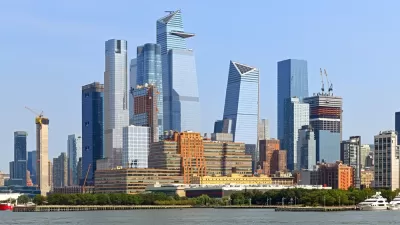Last week saw the second major groundbreaking on the west side of midtown Manhattan in the last two months, as the $4.5 billion "Manhattan West" project’s first phase officially began.
Just last month, "the largest private real estate development in the history of New York" broke ground on the far west side of Manhattan. Now comes news that, just a few blocks east of Related's Hudson Yards "mini-city", "Brookfield Properties’ trio of new SOM-designed towers comprising the Manhattan West development" has started construction atop train tracks just west of Penn Station and the Farley Post Office building, reports Branden Klayko.
At the grounbreaking ceremony, Mayor Bloomberg remarked that, “From Battery Park to Riverside Park, it’s just amazing how much development there has been all along the west side; an area everybody thought did not have the potential to become a hot neighborhood. Manhattan West will be a prime location in which to live or work, a vital piece of the mixed-use community we’ve envisioned for the Hudson Yards area, which is beginning to take shape.”
"Twin office towers with retail space will anchor the corners of the site, each with two million square feet of office space, and a third residential building will be built along West 31st Street for a total of 5.4 million square feet of space." notes Klayko. "In addition to the three towers, Manhattan West also calls for a 100-foot-wide swatch of new public space between the office towers built on the new platform. High Line designers James Corner Field Operations will design the new 1.5-acre landscape, which is imagined as a recreated 32nd Street forming a pedestrian link with Hudson Yards and park amenities farther west."
The complex choreography that will allow the platform and towers to be built atop the now-exposed tracks, while trains continue to operate is illustrated in the video below:
FULL STORY: Manhattan West’s Railyard-Spanning Platform Breaks Ground

Alabama: Trump Terminates Settlements for Black Communities Harmed By Raw Sewage
Trump deemed the landmark civil rights agreement “illegal DEI and environmental justice policy.”

Study: Maui’s Plan to Convert Vacation Rentals to Long-Term Housing Could Cause Nearly $1 Billion Economic Loss
The plan would reduce visitor accommodation by 25% resulting in 1,900 jobs lost.

Why Should We Subsidize Public Transportation?
Many public transit agencies face financial stress due to rising costs, declining fare revenue, and declining subsidies. Transit advocates must provide a strong business case for increasing public transit funding.

Paris Bike Boom Leads to Steep Drop in Air Pollution
The French city’s air quality has improved dramatically in the past 20 years, coinciding with a growth in cycling.

Why Housing Costs More to Build in California Than in Texas
Hard costs like labor and materials combined with ‘soft’ costs such as permitting make building in the San Francisco Bay Area almost three times as costly as in Texas cities.

San Diego County Sees a Rise in Urban Coyotes
San Diego County experiences a rise in urban coyotes, as sightings become prevalent throughout its urban neighbourhoods and surrounding areas.
Urban Design for Planners 1: Software Tools
This six-course series explores essential urban design concepts using open source software and equips planners with the tools they need to participate fully in the urban design process.
Planning for Universal Design
Learn the tools for implementing Universal Design in planning regulations.
Smith Gee Studio
Alamo Area Metropolitan Planning Organization
City of Santa Clarita
Institute for Housing and Urban Development Studies (IHS)
City of Grandview
Harvard GSD Executive Education
Toledo-Lucas County Plan Commissions
Salt Lake City
NYU Wagner Graduate School of Public Service




























